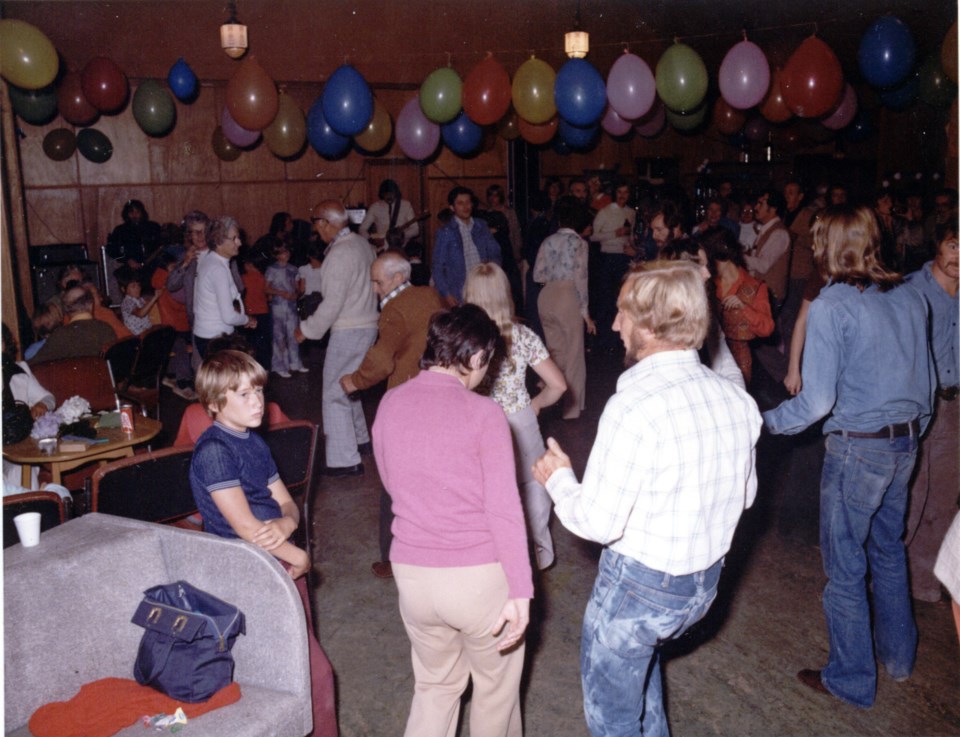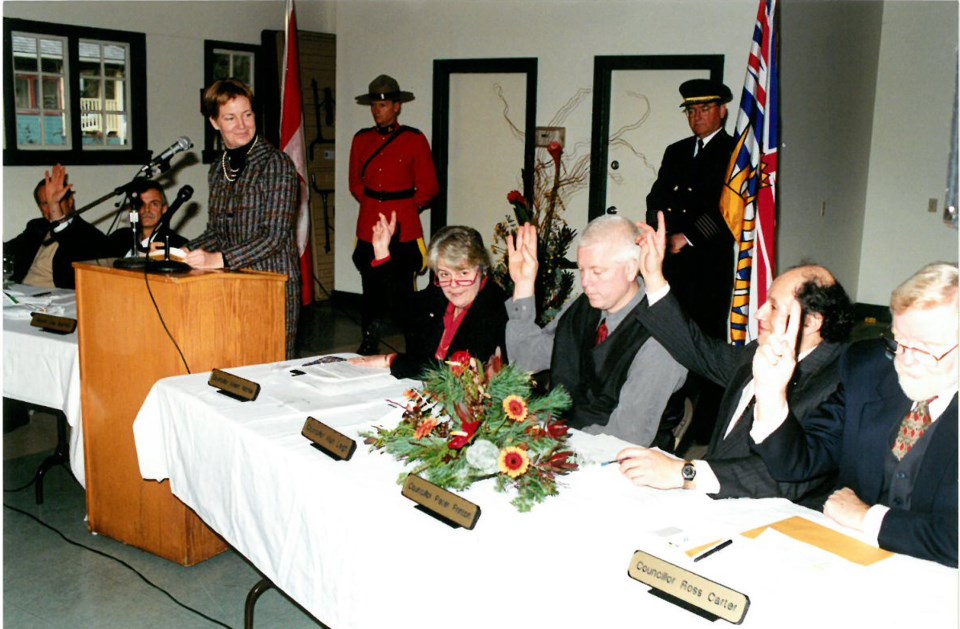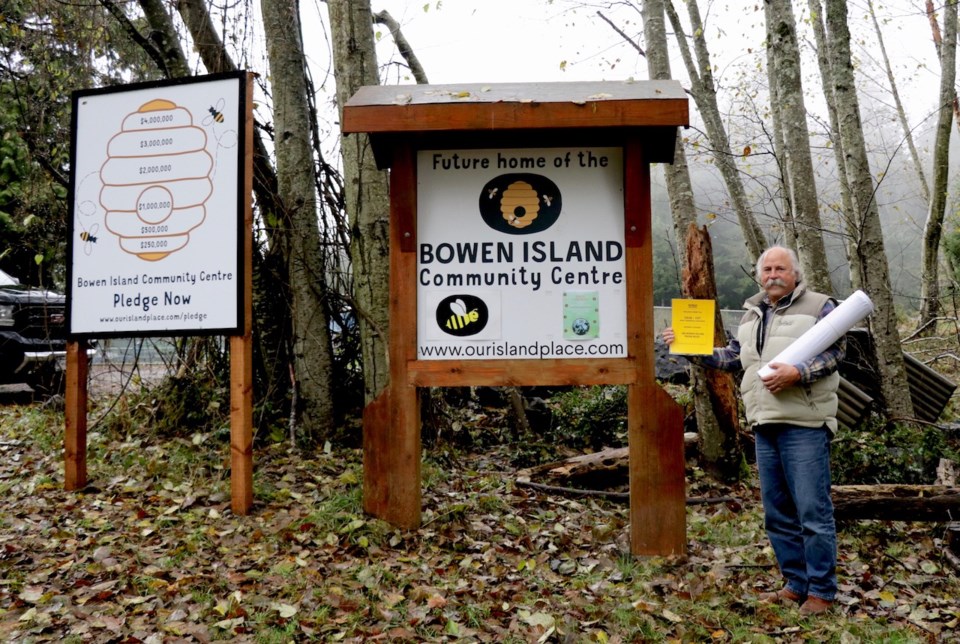In the late ‘80s, a hundred people would fill the Behm family’s Hummingbird Lane home to take in a classical music concert.
Often the performance would require a grand piano. “We had to push it uphill, in through the back door, up some stairs, through the dining room, down some stairs and then position it and make sure it was tuned right,” recalls H.C. Behm. A monstrous task but well worth it. With a view at their backs and two floors of audience members before them, renowned musicians brought the world to Bowen Island.
The task of creating a community hall is embedded in one of Bowen’s best-known non-profits. One of the founding mandates of Bowen Island Arts Council––rebranded as ‘the Hearth’ a couple of years ago––was to see a dedicated performing arts space built on-island. That was 1987. Behm was a founder.
The idea was not new then.
A community centre was percolating as far back as the mid-1950s when Leslie Wallwork proposed turning the former Union Steamship General Store into “The Shakespeare Arms,” a sort of English tavern to have “community, good conversation and theatrical and musical performances,” says granddaughter Sarah Haxby.
Union Steamship’s dominance on Bowen faded as the ‘50s wore into the ‘60s––the company closed and demolished its hotel and tore down the lower dance hall. And communities built other spaces: Collins’ Hall was built in 1964 and Legion Hall came a few years later.
It was Union Steamship’s abandoned clubhouse Evergreen Hall, though, that in the ’70s set the stage for Theatre on the Isle’s (TOTI) first play––the five-person melodrama The Drunkard. No one in the cast had theatre experience except TOTI founding member Martin Clarke but the enthusiastic crew put on three shows in 27 hours performing for nearly 200 of the island’s few hundred inhabitants. Dances, plays, potlucks and Bowfests found a place at Evergreen Hall. “It was a community centre,” said Clarke.

When the property was up for sale for $30,000 in about 1978, a crew of islanders wanted to buy it (there was no municipality at the time), but no one had the money. “It was a lot of money,” said Clarke. “And most people who were interested in buying it still had mortgages.”
In that era, Bowen Islanders voted in a referendum to contribute $180,000 toward a new community school. (The Greater Vancouver Regional District entered the agreement with the school district). With a gym, library, multi-purpose room, the building was promoted as a recreation space for all. “Bowen is well-known for its creative and artistic people––get to know them at classes and meetings at the centre,” read a referendum fact sheet. The school was built in 1978 and paid off in 2000.
“That was a good stopgap measure but then the programming became so intense,” said Behm. With priority going to school and recreation programming, there was little time for arts and culture. Community centre studies and reports of the ’90s note the community use of the school waned as school use, function and population grew.
Haxby, now community school coordinator at BICS, was a teenager in the early ’90s and was inspired by the legacy of the grandfather she’d never met. “I joined the Bowen Island Arts Council as the youth representative and volunteered to be part of Paul Hoosen’s Dream Team to envision what a long-needed Community Centre could look like.”
Paul Hoosen is another founding member of the arts council. He has a sturdy black briefcase that won’t fully close packed with reports, studies and notes he’s gathered since taking on the community hall cause in the early ’90s.
In those decades since, committee after committee has set its sights on building a community-owned centre or hall on the island, citing rising population and lack of adequate recreation and culture spaces. Committees have originated from the Arts Council, the Recreation Commission, the GVRD and Bowen Island Municipality.
In 1995, the Nicholson Tamaki Bowen Island Community Centre Feasibility Report (which came following the 1993 ‘Direction for a livable Bowen Island’ Parks and Recreation Task Force report) proposed a $4.8 million, 26,400 square foot centre including a library, flexible activity space, multiuse hall and auditorium. It didn’t proceed.
In 1997 the community turned down a relatively slap-dash proposal for a 4,500 square foot community building on Cates Hill (Bowen’s then GVRD director Richard Littlemore told the Bowen Breeze that the design was drawn up “in two or three weeks in May”). The community asked if it was willing to borrow $750,000 for the “temporary” space, meant to suit the island’s needs in the short term, and voted 536 to 446 not to proceed. Proponents of the time pointed to an island-wide mailout of an interview between Breeze editor Sandi Whyte and Littlemore in which Whyte criticized architect selection, public process and questioned the tax implications for the failure of the referendum.
In December of 1999, Bowen Island Municipal Council gathered in another unofficial community centre of the era––the Old General Store––for its inaugural meeting. The building would later become the public library and see the addition of Cove Commons.

In 2005, islanders voted (with 80 per cent of the vote) to allow BIM to buy 40 acres from Metro Vancouver, what’s now known as the Community Lands. “The Community Lands really set the stage for being able to build a facility,” said Peter Frinton––he was re-elected to council in 2005. “So the modern iteration, that began around that time.”
In the decade and a half since, committee after committee refined the community hall. Community services and amenities to be attached varied, but the hall was consistent. Current and former members of community and civic centre committees generally agree that the design of today is part of this project spanning more than 15 years.
John Reid chaired the Civic Facilities Working Group between 2006 and 2008. “We were a group put together to marry both the arts and rec in the same facility,” he said. “There was always this knowledge that it had to be something that serves everybody’s purposes and not just one or the other.”
The selection of the community centre site beside the school soccer field and the idea of the ‘community living room’ came out of that era. “I want to be sitting there,” said Reid. “I’m planning to retire and I want to sit in front of the fireplace in the middle of the community.”
Shari Ulrich chaired the next committee, ending her tenure in 2012 with proposed $11 million 18,900 square foot centre that included municipal hall. Council of the era balked at the price tag and then councillor and local developer Wolfgang Duntz proposed a cheaper iteration that didn’t proceed.
The community centre referendum is Sept. 12 between 8 a.m. and 8 p.m. at BICS. See more information here.



